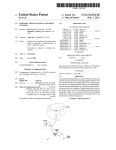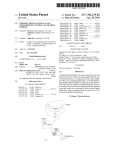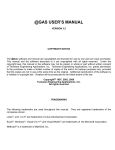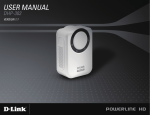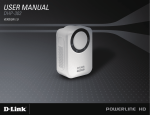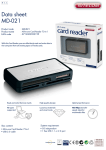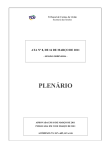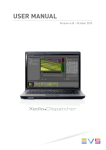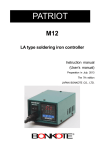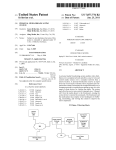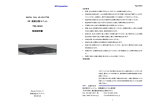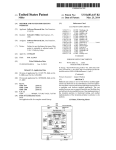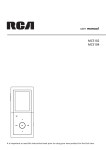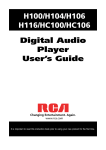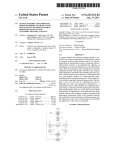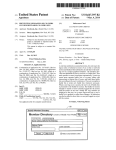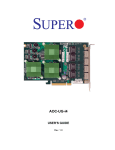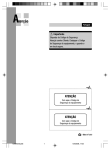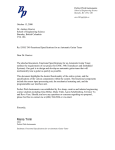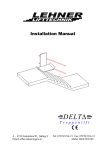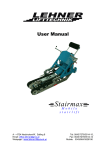Download \ Meladala request
Transcript
US008315555B2
(12) United States Patent
K0 et a].
(54)
PORTABLE MEDIA PLAYER AS A REMOTE
CONTROL
(56)
(75) Inventors: Steve Ko, San Francisco, CA (US);
(Us)
(73) Assignee: Apple Inc., Cupertino, CA (US)
Notice:
Subject to any disclaimer, the term of this
patent is extended or adjusted under 35
U.S. PATENT DOCUMENTS
A
12/1998 Alley et al.
B1
B2
B2
B1
B2
7,702,279 B2
2/2001
7/2005
6/2007
6/2007
8/2009
4/2010
Abecassis
Vidal
Vidal
Sparrell et al.
Tupman et al.
Ko et al.
8,090,309 B2 *
8,112,032 B2 *
1/2012
2/2012
Krampf et al. ............. .. 455/305
Ko et al. .................... .. 455/306
U.S.C. 154(b) by 0 days.
(Continued)
This patent is subject to a terminal dis
claimer.
FOREIGN PATENT DOCUMENTS
JP
2003-281169
(21) Appl. N0.: 13/360,947
(22)
Filed:
OTHER PUBLICATIONS
Prior Publication Data
US 2012/0129446 A1
International Search Report & Written Opinion for International
Patent Application PCT/US2006/047825, mailed May 9, 2007.
May 24, 2012
(Continued)
Related US. Application Data
(63)
(51)
Primary Examiner * Tan Trinh
Continuation of application No. 12/ 612,493, ?led on
Nov. 4, 2009, noW Pat. No. 8,112,032, Which is a
continuation of application No. 11/314,291, ?led on
Dec. 20, 2005, noW Pat. No. 7,702,279.
(74) Attorney, Agent, or Firm * Dorsey & Whitney LLP
(57)
ABSTRACT
A portable multimedia player is used to Wirelessly access and
control a media server that is streaming digital media by Way
Int. Cl.
H04H 7/00
10/2003
(Continued)
Jan. 30, 2012
(65)
*Nov. 20, 2012
References Cited
5,845,282
6,192,340
6,914,551
7,230,563
7,231,516
7,574,177
Stephen O. Lemay, San Francisco, CA
(*)
US 8,315,555 B2
(10) Patent N0.:
(45) Date of Patent:
(2006.01)
of a Wireless interface to a media unit such as a stereo/speak
(52)
US. Cl. ................... .. 455/3.06; 455/3.03; 455/3.05;
ers in the case of streaming digital audio. In one embodiment,
455/3.04; 455/420; 725/61; 725/86
the portable multimedia player is Wirelessly synchronized to
(58)
Field of Classi?cation Search ............... .. 455/3.06,
a selected one(s) of a number of digital media ?les stored on
the media server in such a Way that digital media ?le metadata
455/3.05, 41.2, 3.01, 44, 45, 150.1, 154.1,
455/185.1, 186.1, 550.1, 3.03, 3.04, 420,
455/509, 517, 556.1, 575.1, 418, 6.3; 709/203,
709/204; 725/81, 85, 86, 135, 31, 61; 705/500,
705/503, 27; 381/77, 104, 107
(song title, author, etc.) associated With the selected digital
media ?le(s) only is transferred from the media server to be
stored in the portable media player.
See application ?le for complete search history.
25 Claims, 7 Drawing Sheets
1
‘(\Media umt
\1
106
1
|
|
1
1
1
\c
D
108
116 +1
114
/
\ Meladala
request
502
Requested
metadata
POHEDIS
mul?msd 13
player 102
100
US 8,315,555 B2
Page 2
US. PATENT DOCUMENTS
2002/0042282 A1
4/2002 Haupt
Communication pursuant to Article 94(3) EPC for European Patent
Application No. 068454818, dated Oct. 31, 2008.
2004/0078812 A1
2004/ 0090984 A1
2004/0133914 A1
4/2004 Calvert
5/2004 Saint-Hilaire et a1.
7/2004 Smith et al.
04.09 .0 1A1 .
2004/0183756 A1*
9/2004
2005/0042983 A1
2/2005 Borgward
2005/0210101 A1*
2005/0273790 A1
2006/0085821 A9
2006/0194612 A1
2007/0214182 A1
9/2005
Keyspan: DMR Software v1.3 for Mac OS XiUser Manual, rev.
Freitas et al. ................. .. 345/73
Janik ........................... .. 709/203
12/2005 Kearney et al.
2009.
4/2006 Simmons et al.
8/2006 Chen
Notice ofAllowance for US. Appl. No. 11/314,291 mailed Dec. 2,
9/2007 Rosenberg
Of?ce Action for Japanese Patent Application No. 2008-547340,
dated Feb. 10, 2011. (with translations).
Extended European Search Report for European Patent Application
No. 101895183, dated Jan. 28, 2011.
Kasahara, “Possible issues and futures of DLNA: DLNA guideline
v1.1 will be released this Jul”, Jan. 26, 2005.
2009.
FOREIGN PATENT DOCUMENTS
WO
WO
Of?ce Action for US. Appl. No. 11/314,291, mailed Oct. 28, 2008.
Of?ce Action for US. Appl. No. 11/314,291, mailed Apr. 21, 2009.
Notice of Allowance for US. Appl. No. 11/314,291 mailed Jul. 17,
02/065732
2005/031605 A1
8/2002
4/2005
OTHER PUBLICATIONS
U.S. Appl. No. 11/245,937, ?led Oct. 7, 2005.
Salling Clicker 2.2.1, User Manual, Salling Software AB, 2005.
Remote for iTunes (URM-15T), product information datasheet,
Keyspan, http://www.keyspan.com/products/usb/urml5t,
down
Noti?cation of the First Of?ce Action for Chinese Patent Application
No. 200680048494 .4, dated Apr. 26, 2011.
Of?ce action for US. Appl. No. 12/612,493, mailed Oct. 13, 2010.
Notice ofAllowance for US. Appl. No. 12/612,493, mailed Mar. 16,
201 1.
loaded Sep. 25, 2005, pp. 1-2.
Notice ofAllowance for US. Appl. No. 12/612,493, mailed Jun. 13,
Express Remote (URM-17A), product information datasheet,
Keyspan, http://www.keyspan.com/products/usb/urml5t, down
Notice ofAllowance for US. Appl. No. 12/612,493, mailed Sep. 28,
loaded Sep. 25, 2005, pp. 1-2.
201 1.
“Keyspan Express Remote Supports Apple’s Airport Express,” Press
Final Of?ce Rejection for Japanese Patent Application No. 2008
547340, dated Jan. 13,2012.
Release, Keyspan, Nov. 10, 2004.
Keyspan: DMR Software v1.3 for Mac OS XiUser Manual, rev.
04.09.01A1, Keyspan.
201 1.
Noti?cation of the Second Of?ce Action for Chinese Patent Appli
cation No. 2006800484944, dated Feb. 22, 2012.
“Keyspan Express Remote,” Product Fact Sheet, Keyspan, Nov.
2004.
* cited by examiner
US. Patent
Nov. 20, 2012
I
US 8,315,555 B2
Sheet 1 0f 7
-J”
\
\
I
I
‘('\Media unit
I
106
I
I
:
112
112
|
'1
I‘
Stereo system
110
1
\
\
\
\
\
\
\
‘x
114
,1
“*\
|
\\
\__
__
__
\\5
Media server
\“~-__../
l
I
1|
104 -\
FIG. 1
Portable
multimedia
player 102
100
US. Patent
Nov. 20, 2012
Sheet 2 of7
SPEAKER
US 8,315,555 B2
200
214
WIRELESS
/
NETWORK
INTERFACE
226
USER
INPUT
208
CODEC
212
DISPLAY
210
II
PROCESSOR
202
I
21,8
BUS
2,24
t
l
‘
I
FILE SYSTEM
Cggg'E
(STORAGE DISK)
204
RAM
ROM
220
222
FIG. 2
/
216 —’ INTERFACE ' '
_
US. Patent
Nov. 20, 2012
Sheet 3 of7
US 8,315,555 B2
310
302-4
' 302-1 I
302-3
3025
302-6
300
FIG. 3
US. Patent
Nov. 20, 2012
Sheet 4 of7
US 8,315,555 B2
Media player generates and
forwards a multimedia metadata -/\_ 402
request to the media server
l
In response to the multimedia metadata
request, the media server locates the
requested metadata associated with the /\_ 404
media ?le(s) stored on the media server
l
Media server provides a multimedia
metadata response back to the
/\_ 406
multimedia player
l
Display plurality of multimedia
metadata by multimedia player
/\ 408
Receive user selection of at least
one of the displayed multimedia -/'\_ 410
metadata
In response to the user selection, the
media player generates and forwards a
multimedia ?le request to the media
-/\_ 412
Media server locates and retrieves an
appropriate media ?le based on the
descriptive information provided in the /\. 414
media ?le request
l
Wireless transfer media ?le from the
media server to a media unit for play
FIG. 4
US. Patent
Nov. 20, 2012
Sheet 5 0f 7
US 8,315,555 B2
a ’ d ' ? . r ‘ ’ ‘.-
\\\
’ ' -"'
\
,J
\\
I,
\
I’
I1
f
‘(\Media unit
\‘
106
112
112
'1
l
I
1
1
Stereo system
110
1'
,'
|
I
1\
\
I’
1
\\
’,~
\\ a‘
114
,1
'“x
I,’
|
\
—__—
1'
\s__ I‘
Media server
','
.|
“- ~__ -1’
104 -\
@
108
FIG. 5A
116 —|+
Metadata
request
502
Requested
\ —
metadata
504
__
\\
Portable
multimedia
‘I player 102
100
US. Patent
Nov. 20, 2012
Sheet 6 017
US 8,315,555 B2
\
I,
‘I
\
,'
‘(\Media unit
l‘
106
I
112
112
l
|
l
'|
1
Stereo system
110
J1
,’
1|I
f
1\
I’
1
\
'1
f,
\
,,’
l/
\\\
\x
114
,'
__
l|
‘*\
I,
|
\\\
xxx‘ __
Media server
|
_"~~__..1'
104 \
[7
Requested
‘El
108
/-
media ?le
504
FIG. 5B
116 —|+
Media ?le
request
602
Portable
/
100
multimedia
‘I player 102
US. Patent
Nov. 20, 2012
Sheet 7 0f 7
US 8,315,555 B2
READ MEDIA PLAYER
INFORMATION FROM THE
MEDIA DATABASE ON
’\_ 602
THE MEDIA PLAYER
COMPARE THE PLAYER MEDIA
INFORMATION WITH HOST
MEDIA INFORMATION FROM
THE MEDIA DATABASE ON THE
HOST COMPUTER
,\-604
DETERMINE WHICH MEDIA
ITEMS TO COPY BASED ON THE /\
COMPARISON INFORMATION
COPY THE DETERMINED MEDIA
ITEMS AND UPDATE THE
APPROPRIATE MEDIA
DATABASE(S)
600
FIG. 6
606
US 8,315,555 B2
1
2
PORTABLE MEDIA PLAYER AS A REMOTE
CONTROL
as changing a song, an entire playlist, or even controlling
volume) a listener Wishing to make such changes must be in
physical contact With the personal computer in Which the
multimedia data being played is stored. For example, if a
listener is in a living room listening to music being streamed
to a living room based stereo by a computer Wirelessly linked
CROSS-REFERENCE TO RELATED
APPLICATIONS
thereto located in an upstairs den, changing the song being
played Would require the listener to physically Walk to the
upstairs den Where the computer Was located and select the
This application is a continuation of US. patent applica
tion Ser. No. 12/612,493, ?led Nov. 4, 2009 now US. Pat. No.
8,1 12,032 and entitled “PORTABLE MEDIA PLAYERAS A
REMOTE CONTROL,” Which is hereby incorporated herein
desired song.
One approach used to solve the problem of remote access
by reference, and Which is in turn a continuation of US.
patent application Ser. No. 11/314,291, ?led Dec. 20, 2005
and control is provided by a Zone based system exempli?ed
now US. Pat. No. 7,702,279 and entitled “PORTABLE
MEDIA PLAYER AS A LOW POWER REMOTE CON
by Sonos Digital Music System manufactured by Sonos, Inc.
of Santa Barbara, Calif. that utiliZes distributed units
(SonosTM Zone Players) and a controller unit (SonosTM Con
TROL AND METHOD THEREOF,” Which is hereby incor
porated herein by reference.
troller). Unfortunately, these units require substantial invest
ment in equipment in order to provide the requisite Zone
based remote access and control. For example, Sonos Digital
BACKGROUND
Music System requires a user to purchase, or otherWise
Due to the increasing capacity and capability of personal
20 acquire, a controller as Well as one or more Zone players
computers, it has become popular to use a personal computer
depending upon the area.
as a repository for multimedia content, such as songs, movies,
Therefore, What is desired is a system that leverages exist
ing devices (such as an iPod, AirPort Express, a Mac running
iTunes) to provide the remote access and control that Would
etc. Particularly With music, the increased popularity of stor
ing multimedia data (in the form of digital audio ?les having
various formats such as MP3, AAC and AIFF) on a personal
25
computer has resulted in a variety of products and services.
For example, music players (e.g., MP3 player), such as the
iPod® multimedia device, and media management applica
tions, such as iTunes softWare, Which as produced by Apple
Inc. of Cupertino, Calif., are popular products. With the abil
ity to store large numbers and types of digital audio ?les in
suchportable music players, services (such as iTunes® Music
SUMMARY
30
lessly access and control a media server (such as a personal
computer running iTunesTM softWare). In one embodiment,
35
playback using portable music players and personal comput
As a portable digital media player capable of communicat
as a primary vehicle for obtaining, storing, and accessing
multimedia data.
40
has improved dramatically in the last several years, these
systems still lag behind typical entertainment devices (e.g.,
stereos, televisions, projection systems, etc.) in terms of per
formance, ?delity, and usability for the typical consumer.
Therefore, in order to utiliZe the higher quality playback
45
systems, it has become common to install home netWork
50
55
With other devices and to serve as a Wireless base station or as
a repeater (to increase the range of a pre-existing Wireless
netWork).
60
can be used to link to any entertainment device, such as a
stereo system, television, or home theatre system. This Would
alloW, for example, streaming of multimedia data from a
personal computer connected to the netWork interface (Wired
or Wireless) to an entertainment device connected to the mul
timedia interface. Unfortunately, hoWever, in order to control
certain aspects of the playback of the multimedia data (such
play a digital media ?le; computer program code for playing
the selected digital media ?le on the portable digital media
player When the portable digital media player is operated in a
?rst mode; and computer program code for Wirelessly send
ing the selected digital media ?le to the media server via the
by Apple Inc. of Cupertino, Calif.) communicates Wirelessly
The netWork interface available on the personal computer
puter program code for displaying a list of digital media ?les
on a display device of the portable digital media player, the
computer program code for receiving a selection signal to
otherWise access this multimedia data stored on a personal
computer using these various entertainment devices. For
example, a Wireless netWork interface (e.g., 802.11g based
Airport Express® Wireless netWork interface manufactured
ing With a media server, one embodiment can, for example,
include at least a Wireless netWork interface, a display device
arranged to display a user interface having a number of user
selectable items, a processor unit con?gured to operate the
portable digital media player in a ?rst mode or a second mode,
and a storage medium con?gured to store computer program
code. The computer program code can includes at least: com
digital media ?les stored on the portable digital media player;
systems Whereby an individual’s personal computer is linked
(either Wirelessly or Wired) to a home entertainment system
forming in the process a media system. The media system
integrates several interfaces and feature sets into an integrated
platform. In this Way, the individual is able to listen, vieW or
media server can stream digital media by Way of a Wireless
interface to a media unit (such as a stereo/ speakers in the case
of streaming digital audio).
ers. In so doing, many consumers use their personal computer
Although the quality of multimedia playback by computers
A portable multimedia player (such as the iPodTM manu
factured by Apple Inc. of Cupertino, Calif.) is used to Wire
Store provided by Apple Inc. of Cupertino, Calif.) have been
developed that alloW consumers to purchase music (and other
digital multimedia data) in a form suitable for storage and
otherWise require the purchase of specialiZed equipment such
as Zone controller units and Zone players.
65
Wireless netWork interface When the portable digital media
player is operated in a second mode.
As a portable digital media player capable of communicat
ing With a media server, another embodiment can, for
example, include at least a Wireless netWork interface, a dis
play device arranged to display a user interface having a
number of user selectable items, a processor unit con?gured
to operate the portable digital media player in a ?rst mode or
a second mode, and a storage medium con?gured to store
computer program code. The computer program code can
includes at least: computer program code for displaying a list
of digital media ?les on a display device of the portable digital
media player, the digital media ?les stored on the portable
digital media player; computer program code for receiving a
US 8,3l5,555 B2
3
4
selection signal to play a digital media ?le; computer program
code for playing the selected digital media ?le on the portable
song) to be played by interacting With the portable multime
dia player. In one implementation, the portable multimedia
digital media player When the portable digital media player is
player can display a plurality of user selectable items that
operated in a ?rst mode; and computer program code for
Wirelessly sending an indication of the selected digital media
correspond to different digital media items (e.g., song ?les).
The user of the portable multimedia player can select one of
the user selectable items to specify a media item to be played.
?le to the media server via the Wireless netWork interface
When the portable digital media player is operated in a second
Once selected, the portable multimedia player Wirelessly
mode.
informs the media server of the speci?ed media item to be
played. In one example, the portable multimedia player trans
mits only some or all of the metadata corresponding to the
neW media item along With a control signal indicating, for
BRIEF DESCRIPTION OF THE DRAWINGS
example, that a media item currently being played is to be
replaced by the neW media item associated With the control
FIG. 1 shoWs a representative Wireless media netWork and
a Wireless battery poWered portable multimedia player in
accordance With an embodiment of the invention.
FIG. 2 shoWs a schematic functional block diagram of a
signal.
portable media player according to one embodiment of the
invention.
FIG. 3 illustrates a representative multimedia player in
can display a user interface that enables the user to control
In another implementation, the portable multimedia player
hoW a media item is to be played. For example, the control
provided can alter, change or provide play characteristic, such
accordance With an embodiment of the invention.
FIG. 4 shoWs a How diagram of remotely accessing a media
20
can be sent since the associated media item is already knoWn
by the media server.
Once received by the media server (e.g., personal com
puter), the media server can then inform the media unit of the
server in order to effect a change to a streamed digital media
?le according to one embodiment of the invention.
FIGS. 5A-5B shoWs hoW the multimedia player can be
used to remotely access the personal computer to effect any
number of changes in the music being streamed to and played
by the stereo.
FIG. 6 that is a How diagram of synchroniZation processing
25
being played by the media unit is discontinued and transfer of
30
media data pertaining to the neW selected media item begins,
such that the neW selected media item can be played. In this
Way, the user can indirectly remotely control the output of the
media unit using a battery poWered portable multimedia
Reference Will noW be made in detail to a particular
embodiment of the invention an example of Which is illus
trated in the accompanying draWings. While the invention
Will be described in conjunction With the particular embodi
control operation requested by the user via the portable mul
timedia player. For example, if the control operation is a neW
selected media item to be played, the current media item
according to one embodiment of the invention.
DETAILED DESCRIPTION
as volume, equalization, etc., or navigation, such as next,
previous, play, stop, etc. In such cases, a control signal alone
player in a poWer e?icient manner.
In yet another embodiment, a portable digital media player
35
(such as an iPod), is bound to a personal computer in such a
ment, it Will be understood that it is not intended to limit the
invention to the described embodiment. To the contrary, it is
Way that the digital media player Wirelessly controls the com
puter. It should be noted, that the binding of the personal
intended to cover alternatives, modi?cations, and equivalents
as may be included Within the spirit and scope of the invention
the digital content stored in the digital media player With the
as de?ned by the appended claims.
According to one embodiment, a battery-operated portable
multimedia player is used to Wirelessly access and/or control
computer and the digital media player includes synchronizing
40
a USB 2.0 or FireWire cable. In this Way, the requirement of
additional user interface on the digital media player for
choosing, connecting to, and authenticating With the com
puter is eliminated. Therefore, in this Way, only an additional
a media server. The media server can be implemented by a
variety of computing devices. As an example, the media
server can be implemented by a personal computer. In
response to such Wireless access and/or control, the media
server can operate to stream digital media by Way of a Wire
less interface to a media unit (e. g., a home audio system, such
as a stereo, in the case of streaming digital audio).
In one embodiment, the portable multimedia player Wire
media items stored in the computer over a connector such as
user interface having a top level menu (“remote control” as an
example) is needed to control the computer Which, When
selected, automatically connects and authenticates the com
puter bound to the portable digital media player.
FIG. 1 shoWs Wireless media system 100 that includes a
50
battery poWered portable multimedia player 102, a media
lessly communicates With the media server so as to receive a
server 104, and a media unit 106 in accordance With an
media catalog of available media items on the media server.
embodiment of the invention. As con?gured, the media server
Here, the media catalog is a listing of the available media
items, e.g., digital media ?les, stored on the media server. In
one embodiment, the media catalog contains media item
104 includes a local storage medium 108 that can take any
appropriate form such as a hard disk drive, ?ash memory, etc.
arranged to store multimedia content 109 that can include
55
metadata (song title, author, etc.). In this embodiment, the
digital media items (e. g., digital media ?les) themselves need
digitiZed music (e.g., songs), short video ?les, or full-length
video ?les (e.g., movies). For the sake of this discussion, the
not be transferred to the portable media player. As a result,
only a relatively small amount of data is required to be trans
media server 104 is taken to be a personal computer arranged
to store a number of digital audio ?les (e.g., song ?les) in the
local storage medium 108 con?gured as a hard drive. In the
described embodiment, the media server 104 is Wirelessly
coupled to the media unit 106 that in this case takes the form
of a stereo system 110 having a number of speakers 112. In
the described embodiment, the stereo system 110 includes a
Wireless netWork interface 114. The Wireless netWork inter
face 114 supports a Wireless netWork. The Wireless netWork
can take the form of, for example, a “WiFi” interface accord
ferred to the portable multimedia player, thereby saving valu
able battery resources. In addition, by not transferring the
60
digital media items themselves, potential copyright infringe
ment issues can be avoided.
When a user Wishes to access and/or control the media
server in order to effectuate a change in the media item data
being streamed to the media unit (e.g., changing a song being
played as an example), the user selects a neW media item (e.g.,
65
US 8,315,555 B2
5
6
ing to the IEEE 802.11b or 802.1 1g standards. Other Wireless
network standards could also be used, either in alternative to
the need for a user to enter IP addresses or con?gure DNS
servers. Various aspects of Bonjour are generally knoWn to
those skilled in the art, and are disclosed in the White paper
the identi?ed standards or in addition to the identi?ed stan
entitled “Bonjour” dated October 2003, and published by
Apple Inc., Which is hereby incorporated by reference in its
dards. Such other netWork standards could include the IEEE
802.11a standard or the Bluetooth standard. An antenna
required for Wireless networking is typically included Within
entirety. Additional implementation details may be found in
the housing of the Wireless netWork interface 114. Such an
the folloWing co-pending patent applications, commonly
antenna may take a variety of forms, such as an antenna
oWned With the present application, Which are hereby incor
printed on a standard PCB (printed circuit board). Such anten
porated by reference in their entirety: (1) “Method and Appa
nas are Well knoWn to those skilled in the art.
ratus for Con?guring a Wireless Device Through Reverse
The Wireless netWork supported by the Wireless netWork
Advertising,” application Ser. No. 10/ 102,321, ?led Mar. 19,
interface 114 can enable Wireless communications betWeen
the media server 104 and the media unit 106. In such case, the
media server 104 also includes or couples to a Wireless net
Work interface 116 such that the media server 104 and the
media unit 106 can communicate over the local Wireless
netWork via the Wireless netWork interfaces 114 and 116.
2002; (2) “Method and Apparatus for Supporting Duplicate
Suppression When Issuing Multicast DNS Queries Using
DNS_Format Message Packets,” application Ser. No. 10/102,
174, ?led Mar. 19, 2002; and (3) “Method and Apparatus for
Implemented a Sleep Proxy for Services on a NetWork,”
application Ser. No. 60/496,842, ?led Aug. 20, 2003.
To facilitate communications betWeen the personal com
puter 104 and the media unit 106, such as to provide media
Furthermore, the portable multimedia player 102 can com
municate With the media server 1 04 in a Wireless manner, over
the same Wireless netWork (as used betWeen the media server
104 and the media unit 106) or another Wireless netWork.
20
supports audio streaming to the media unit 106. As required
for standard Bonjour operation, the Wireless netWork inter
When the media unit 106 described herein is used to play
multimedia content from the media server 104 (hereafter
personal computer), the media unit 106 is plugged into a Wall
outlet for poWer. The Wireless netWork interface 114 acts as a
25
Wireless base station for the Wireless netWork thus enabling
the personal computer 104 to communicate With the media
unit 106. The Wireless netWork interface 114 is also con
nected to the stereo system 110 to enable playback of audio
?les stored on the computer 104 by the stereo system 110. The
connection betWeen the Wireless netWork interface 114 and
device, and one or more con?guration parameters that are
30
tises particular audio capabilities of the system (e.g., 44.1
kHZ sample rate, 16-bit sample siZe, and 2-channel/stereo
samples). The registration of the service might also include
35
or parameters that are necessary for communicating With the
device.
In alternative embodiments, additional services may be
designed to specify a variety of parameters relating to one or
security, encryption, compression, and other capabilities and/
cable that Would connect to a digital audio input port on the
stereo system 110.
more multimedia input or output devices attached to the
media unit 106. Devices that might have particular applica
the personal computer 104 over a Wireless netWork connec
tion and output this media information to an entertainment
device (e.g., the stereo system 110). Although it is contem
plated that audio, video, audio/video, and/or other forms of
face 114 Will publish the availability of a service, the name of
the device providing the service, the netWork address of the
related to the service. The registration of this service adver
the stereo system 110 may be by Way of a digital ?ber optic
As brie?y described above, the Wireless netWork interface
114 has the ability to receive multimedia information from
sharing functionality, the Wireless netWork interface 114 for
the media unit 106 Will advertise over the netWork that it
bility in a home netWork environment include speakers, video
display terminals, cameras, microphones, etc.
40
The automatic discovery aspects of devices Within the net
multimedia may be used With the media system described
herein, one exemplary embodiment relates to the sharing of
Work permit its use in architecting easily con?gured home
audio data stored on a personal computer With an entertain
ment device, such as a stereo system.
example, a user With a large library of music on a computer in
To provide a relatively simple and user friendly interface to
the media output features of media unit 106, it is advanta
netWorks according to a user’s preferences and designs. For
one room of a house can create a Wireless multimedia netWork
45
for his entire home simply by deploying a feW of the disclosed
Wireless netWork interfaces throughout his home. For
geous to provide access to the media unit 106 from a media
example, he can put one near the stereo in the living room, and
application running on the personal computer 104, Which is
also preferably the application normally used to create,
one by the television in the bedroom. By connecting the
appropriate multimedia interface, he can serve audio, video,
manipulate, or otherWise access the particular type of media
?le. In one exemplary embodiment, the media application be
the iTunes® softWare for music management and playback
50
55
room stereo to play his favorite album, and he may direct the
bedroom television to shoW a home movie. This extensible
architecture alloWs a user to con?gure relationships betWeen
sources and destinations of media data Without regard or need
60
for buying all components from the same vendor, or other
such considerations that might otherWise be required to per
mit interoperability of disparate devices on a Wireless net
Work.
Once the Wireless netWork interface 114 is discovered on
produced by Apple Inc. Using the media application, the
media unit 106 may be selected as a destination for media
playback. The personal computer 104 can be programmed
such that the audio content of a media ?le to be played Will be
sent to the media unit 106, While system sounds (e. g., beeps,
alerts, etc.) Will continue to be presented at the personal
computer 104.
Communications betWeen the personal computer 104 and
or other content to these devices With a simple selection at his
personal computer. For example, he may direct the living
the Wireless netWork, the media softWare running on personal
computer 104, e.g., iTunes, Will recogniZe the associated
the media unit 106 over a Wireless netWork (e.g., Wireless
netWork 100) is initiated through a discovery process. One
example of such a discovery process uses Bonjour, Which is a
stereo system 110 as a destination for audio data, and Will
technology that enables automatic discovery of computers,
automatically provide the particular device (e.g., stereo sys
devices, and services on IP netWorks. Also knoWn as Zero
65
tem 110) as a selectable destination Within the user interface.
Con?guration NetWorking, Bonjour uses standard IP proto
When the user selects a particular device from those avail
cols to alloW devices to automatically ?nd each other Without
able, a variety of authentication and security exchanges can
US 8,315,555 B2
7
8
take place. For example, if passWord protection is provided as
received. Additionally, it is also possible for the buffer to have
a security feature, the user may be prompted for a password
required to use the media unit 106 (i.e., stereo system 110) for
audio ?le playback. Additionally, if the user attempts to select
a device that is already in use (for example, by another user),
the media unit 106 (i.e., Wireless network interface 114) Will
send a message indicating that it is busy through the user
interface.
?c or reliability conditions.
In a preferred embodiment, the audio channel is separate
from a control channel. For reasons explained beloW, it is
advantageous to have the data channel separate from the
control channel. HoWever, a single channel could be used for
data and control information.
a varying capacity, determined, for example, by netWork traf
Once a connection is established betWeen a media source,
One advantage to using separate control and data channels
e.g., a personal computer 104, and the Wireless netWork inter
is improved response to user commands. As noted above, the
face 114 media data corresponding to one or more media
media unit 106 includes buffering of data, Which compen
sates for netWork delays, latency, etc. If control commands
items (e.g., songs) can be transmitted from the personal com
puter 104 to the Wireless netWork interface 114. The trans
mission can pertain to a ?le transfer of the media data (media
?le) or streaming of the media data. The connection remains
open so long as media data is being transmitted. Once media
data is no longer being transmitted, for example, at the end of
playback of a song or album, the connection enters an “idle”
state. While in this idle state, the media source can begin
are included in the data stream, these commands Would not be
reached until the media unit 106 plays through the buffer,
20
audio data) are preferably TCP packets in the general form
successfully transmitting data at any time, as the connection
has not been closed. Thus, it Would not be necessary to rene
gotiate or otherWise reestablish the connection.
HoWever, While the media source has a connection in this
“idle” state, it can also accept an attempt to establish a con
nection With another media source. If such an attempt occurs,
the connection With the ?rst media source Will be closed and
a neW connection Will be established. Preferably, in such case,
the ?rst source Will also be noti?ed that its connection has
been terminated.
speci?ed by the real-time streaming protocol (RTSP) stan
dard. RTSP is a standard communication protocol knoWn to
25
30
particularly in applications Where the overhead associated
authoriZed to receive an audio data stream and/or that the
35
40
decrypt the data. The media softWare and the media unit 106
may determine Which of their respective pluralities of keys to
use based on the exchange of a key index, telling them Which
of their respective keys to use Without the necessity of trans
detecting missing packets or reordering packets because TCP
automatically provides guaranteed packet delivery and cor
For example, the media unit 106 may periodically provide
45
information about Where it is in the playback of the media
stream. This may be accomplished by the media unit 106
transmitting over the control channel an indication of the
packet currently being played back. Alternatively the media
50
unit 106 may indicate the packet just received as Well as the
status of the device’ s buffers. This information is useful to the
media softWare for multiple purposes. For example, if the
media softWare determines that the buffers on the media unit
106 are loW, additional data may be transmitted to the device
in faster than real time, to insure that the device’s buffers do
It is preferable that authentication of a media unit 1 06 occur
upon initial establishment of a connection to the media soft
55
running on personal computer 104 Will open a netWork con
nection to the media unit’s audio channel and begin sending
data. In this embodiment, the media data is “pushed” from the
media softWare to media unit 106 rather than being “pulled”
by the media unit 106 from the media softWare. The media
data received by the media unit 106 can be played by the
media unit 106, namely, played by the stereo system 110. The
media unit 106 receives this audio data, buffers some portion
of the data, and begins playing back the audio data once the
buffer has reached a predetermined capacity. For example, the
protocol) headers, and Will include both sequence numbers
and time stamp information. HoWever, When TCP is used, this
sequence and time stamp information is not required for
rect sequencing. HoWever, the timing and sequence informa
mitting entire keys.
Ware. Upon successful authentication, the media softWare
With TCP Would be undesirable.
In either case, the data packets can use RTP (real time
tion is useful for feedback from the media unit 106 to the
media control softWare.
the media unit 106 to the media softWare to be digitally signed
by the media unit 106 using its private key, by Which it can be
authenticated by the media softWare using the appropriate
public key. Similarly, data sent from the media softWare to the
media unit 106 may be encrypted using a public key so that
only a media unit 106 using the corresponding private key can
mission control protocol) is preferably used because of its
robustness, UDP (user datagram protocol) may also be used,
may be desirable to determine that the media unit 106 is
keys embedded in read only memory (ROM). The media
softWare is then provided With a corresponding plurality of
public keys. This alloWs identi?cation data transmitted from
those skilled in the art. Therefore, implementation details of
such a system are not discussed here, although they may be
found in Real Time Streaming Protocol Speci?cation dated
Feb. 16, 2004, and prior versions, presently available from
http://WWW.rtsp.org and Which are hereby incorporated by
reference in their entirety. Additionally, although TCP (trans
Additionally, for digital rights management purposes, it
communications link betWeen the personal computer 1 04 and
the media unit 106 is secure (e.g., encrypted). Typically, this
requires some form of authentication, and is preferably based
on a public key/private key system. In one embodiment, each
media unit 106 may be provided With a plurality of private
meaning there Would be a delay of up to several seconds
before implementing the user command. This is obviously
undesirable, and thus a separate channel for control data
provides an enhanced user experience.
The packets sent over the data channel (in this example the
60
not become completely empty. This information may also be
used by the media softWare for synchronizing visual effects
displayed on a monitor (display) of the personal computer
104 or other device With the sound being output from the
media unit 106 (i.e., the stereo system 110). Visual effects to
be synchroniZed With the audio playback may take a variety
of forms, including various artistic “visualizations,” Which
provide visual effects that are synchronized With the “beats”
of the music.
Another use for the packet sequence and time stamp infor
media unit 106 may have a total of 8 seconds of buffering, but
mation relates to the case in Which the media unit 106 receives
an instruction to stop playback and discard all data received
may begin playback When 2 seconds of audio data have been
up to that point. In such a case, buffering by the media unit
65
US 8,315,555 B2
9
10
106 requires that the packets to be discarded be identi?ed,
Which is most readily accomplished using the sequence and
and the processor 202. The media player 200 also includes a
bus interface 216 that couples to a data link 218. The data link
218 alloWs the media player 200 to couple to a host computer
timestamp information.
The data payload of the RTP packets contains the audio
over a Wired connection.
information to be played back by the media unit 106. In a
preferred embodiment, media ?les may be stored on personal
computer 104 in one or more formats, including, for example,
plurality of media assets (e.g., songs) in the ?le system 204.
MP3 (Motion Picture Expert’s Group Layer 3), AAC (Ad
particular media item, a list of available media assets is dis
vanced Audio Coding a/k/a MPEG-4 audio), WMA (Win
played on the display 210. Then, using the user input device
In one embodiment, the media player 200 serves to store a
When a user desires to have the media player 200 play a
doWs Media Audio), etc. The media softWare running on the
208, a user can select one of the available media assets. The
personal computer 104 decodes these various audio formats,
processor 202, upon receiving a selection of a particular
eliminating the need for the media unit 106 to include decod
ers for multiple formats. This also reduces the hardWare per
formance requirements of media unit 106. Yet another advan
particular media item to a coder/ decoder (CODEC) 212. The
media item, supplies the media data (e.g., audio ?le) for the
CODEC 212 then produces analog output signals for a
tage of performing decoding on the personal computer 104 is
speaker 214. The speaker 214 can be a speaker internal to the
media player 200 or external to the media player 200. For
example, headphones or earphones that connect to the media
player 200 Would be considered an external speaker.
that various effects may be applied to the audio stream, for
example, cross fading betWeen tracks, volume control, equal
iZation, and/ or other audio effects. Many of these effects
Would be dif?cult or impossible to apply if the media unit 106
Were to apply them, for example, because of computational
For example, in a particular embodiment, the available
20
upon a selected number and type of groupings appropriate to
the available media assets. For example, in the case Where the
resources required.
In one embodiment, the decoded audio data is compressed
by personal computer 104 before transmission to media unit
106. This compression is often accomplished using a lossless
compression algorithm to provide maximum audio ?delity.
media player 200 is an MP3 type media player, the available
25
One suitable compressor is the Apple Lossless Encoder,
Which is available in conjunction With Apple’ s iTunes® soft
Ware. The media unit 106 does require a decoder for the
compression codec used. It is also desirable that the data
stream sent from personal computer 1 04 to the media unit 1 06
be encrypted. One suitable form of encryption is AES using a
30
pre-de?ned key determined as described above.
FIG. 2 shoWs a schematic functional block diagram of a
portable media player 200 according to one embodiment of
the invention. The media player 200 is, for example, suitable
for use as the battery poWered portable multimedia player 1 02
35
shoWn in FIG. 1. The media player 200 includes a processor
202 that pertains to a microprocessor or controller for con
40
204 typically provides high capacity storage capability for the
media player 200. HoWever, since the access time to the ?le
system 204 is relatively sloW, the media player 200 can also
include a cache 206. The cache 206 is, for example, Random
45
Access Memory (RAM) provided by semiconductor
memory. The relative access time to the cache 206 is substan
tially shorter than for the ?le system 204. HoWever, the cache
206 does not have the large storage capacity of the ?le system
204. Further, the ?le system 204, When active, consumes
50
more poWer than does the cache 206. The poWer consumption
portable media player that is poWered by a battery (not
interface 226 arranged to Wirelessly transmit any selected
data from the media player 200 to any appropriately con?g
ured receiver unit (e.g., the Wireless netWork interface 114)
the Wireless netWork interface 226 that takes the form of, for
example, a “WiFi” interface according to the IEEE 802.1 lb or
802.11g standards. Other Wireless netWork standards could
also be used, either in alternative to the identi?ed standards or
in addition to the identi?ed standards. Such other netWork
standards could include the IEEE 802.11a standard or the
Bluetooth standard.
In one embodiment, the media player 200 is a portable
computing device dedicated to processing media such as
audio. For example, the media player 200 can be a music
player (e.g., MP3 player), a game player, a remote controller,
a portable communication device, and the like. These devices
are generally battery-operated and highly portable so as to
trol other devices. In one implementation, the media player
55
200 is a handheld device that is siZed for placement into a
pocket or hand of the user. By being handheld, the media
player 200 is relatively small and easily handled and utiliZed
by its user. By being pocket siZed, the user does not have to
directly carry the device and therefore the device can be taken
programs, utilities or processes to be executed in a non
volatile manner. The RAM 220 provides volatile data storage,
such as for the cache 206.
The media player 200 also includes a user input device 208
that alloWs a user of the media player 200 to interact With the
can be arranged hierarchically as a list of music genres at a
?rst level, a list of artists associated With each genre at a
second level, a list of albums for each artist listed in the
second level at a third level, While at a fourth level a list of
songs for each album listed in the third level, and so on.
The media player 200 also includes a Wireless netWork
alloW a user to listen to music, play games or video, record
video or take pictures, communicate With others, and/ or con
is particularly important When the media player 200 is a
shoWn). The media player 200 also includes a RAM 220 and
a Read-Only Memory (ROM) 222. The ROM 222 can store
media assets take the form of MP3 ?les (each of Which cor
responds to a digitally encoded song or other audio rendition)
stored at least in part in the ?le system 204. The available
media assets (or in this case, songs) can be grouped in any
manner deemed appropriate. In one arrangement, the songs
over a Wireless netWork. In the embodiment shoWn in FIG. 1,
trolling the overall operation of the media player 200. The
media player 200 stores media data pertaining to media assets
in a ?le system 204 and a cache 206. The ?le system 204 is,
typically, a storage disk or a plurality of disks. The ?le system
media assets are arranged in a hierarchical manner based
60
almost anyWhere the user travels (e. g., the user is not limited
by carrying a large, bulky and often heavy device, as in a
portable computer). Furthermore, the device may be operated
media player 200. For example, the user input device 208 can
take a variety of forms, such as a button, keypad, dial, etc. Still
information to the user. A data bus 224 can facilitate data
by the users hands, no reference surface such as a desktop is
needed.
The multimedia player 102 can be used to remotely access
and/or control the personal computer 104 to effect any num
transfer betWeen at least the ?le system 204, the cache 206,
ber of changes in the music being streamed to and played by
further, the media player 200 includes a display 210 (screen
display) that can be controlled by the processor 202 to display
65
US 8,315,555 B2
11
12
the media unit 106, namely, the stereo system 110. Such
the metadata corresponding to the selected media item and is
changes include selecting different songs, playlists, changing
then forWarded to the media server 412. It should be noted
volume, bass, treble, etc. each at the discretion of the user of
that the media ?le request need only include descriptive infor
mation (e.g., metadata) necessary to uniquely identify the
the multimedia player 102.
FIG. 3 illustrates a representative multimedia player 300 in
selected song by the media server. At no time is the song data
itself transferred from the media player to the media server,
accordance With an embodiment of the invention that is suit
able for use as the multimedia player 102 illustrated in FIG. 1
thereby avoiding any copyright infringement based upon pro
having a number of input buttons 3 02. Such input buttons 3 02
tected content. Indeed, it may be that the multimedia player
does not include the song data. In addition, since the media
?le request represents a small data transfer (on the order of a
feW kilobytes), the amount of poWer required for the genera
tion and forWarding of the media ?le request from the multi
take the form of a rotatable dial 302-1 in the form of a Wheel
capable of rotation in either a clockWise or counterclockwise
direction having at its center a depressable input button 302-2
arranged to receive a user input event such as a press event.
Other input buttons 302 include input buttons 302-3 through
media player to the media server is substantially reduced over
that Which Would be required to send the full media ?le. In this
302-6 each available to receive user supplied input action. It
should be noted that each of the above described buttons can
be programmed or otherWise con?gured singly or in any
combination to perform a particular function or suite of func
tions. For example, if so desired, the rotatable dial 302-1 can
be con?gured to associate a scroll forWard function With a
clockWise rotation of the dial 302-1 and a scroll back function
With a counterclockwise rotation, or vice-versa. In another
situation, a user can con?gure the dial 302-1 to scroll forWard
With a clockWise rotation in combination With a user supplied
input event in the form of a press of the depressable button
302-2 to scroll forWard in discrete steps, for example, as
Way, a user can effectively provide remote control of the
media unit, e.g., the stereo system, by Way of the media server
Without adversely affecting battery life of the multimedia
player.
20
Once the media server has received the media ?le request,
an appropriate media ?le is retrieved from the media server
and Wirelessly forWarded by Way of the Wireless netWork
interface across the Wireless netWork to a media unit (such as
25
the stereo 110). In some cases, the media ?le being Wirelessly
forWarded is accompanied by an associated control command
to control the stereo system, such as to change the volume,
opposed to a continuous scroll action. In this Way, a user can
treble, bass, etc.
program any of the buttons 302 (singly or in any combination)
to perform any function.
Although the multimedia player 300 makes use of the dial
FIGS. 5A-5B graphically illustrate a data How betWeen the
multimedia player 102, the media server 104, and the media
302-1 and various input buttons 302-2 through 302-6, in
30
another embodiment, the dial 302-1 can be replaced by a
touch pad, preferably a touch pad supporting circular inputs.
Also, the buttons 302-2 through 302-6 can be provided else
Where. For example, if a touch pad is used, the buttons 302-2
through 302-6 can be associated With portion of the touch
35
pad, dispersed about and beyond the outer periphery of the
touch pad, or provided underneath the touch pad.
FIG. 4 shoWs a How diagram of remotely accessing a media
server in order to effect a change to a streamed digital media
?le according to one embodiment of the invention. The pro
catalog is typically predetermined and stored on the media
server. HoWever, if not, the catalog can be generated When
requested. The catalog requested need not be for all the media
502 is a request for a catalog of all media items available on
40
mined and stored on the personal computer 104. HoWever, if
not, the catalog canbe generated When requested. The catalog
requested need not be for all the media items available on the
personal computer 104. In any event, for a given media item
45
(e.g., song), the metadata can include, song title, author, track
duration, etc. that corresponds to the requested song and is
typically much smaller in siZe than the associated media ?le.
Once the metadata has been identi?ed, the personal computer
104 can provide a multimedia metadata response 504 back to
50
items available on the media server. In any event, for a given
media item (e. g., song), the metadata can include, song title,
author, track duration, etc. that corresponds to the requested
song and is typically much smaller in siZe than the associated
media ?le. Once the metadata has been identi?ed, the media
player 102 generates a multimedia metadata request 502 that
is then forWarded to the personal computer 104. In response
to the multimedia metadata request 502, the personal com
puter 104 locates the requested metadata associated With the
media ?le(s) 106 (e.g., audio tracks) stored on the personal
computer 104. Typically, the multimedia metadata request
the personal computer 104. The catalog is typically predeter
cess 400 begins by the multimedia player generating a mul
timedia metadata request that is then forWarded to the media
server 402. In response to the multimedia metadata request,
the media server locates the requested metadata associated
With the media ?le(s) 404 stored on the media server. Typi
cally, the multimedia metadata request is a request for a
catalog of all media items available on the media server. The
unit 106 in accordance With an embodiment of the invention.
Once a user has interacted With the multimedia player 102 to,
for example, select a neW song to be played, the multimedia
the multimedia player 102 for storage thereon. In this case,
the song title, author or other identifying indicia is returned to
the multimedia player 1 02 Where it is stored for later retrieval.
Once the appropriate metadata (e.g., catalog of available
media items) is stored on the multimedia player 102, a user
55
has the option of selecting any of the media items associated
With the stored metadata to be remotely played. For example,
server can provide a multimedia metadata response 406 back
the user can select a neW song to be played using the GUI 310
to the multimedia player for storage thereon. In this case, the
song title, author or other identifying indicia is returned to the
multimedia player Where it is stored for later retrieval.
that can display at least a portion of the stored metadata that
Once the appropriate metadata (e.g., catalog of available
60
media items) is stored on the multimedia player, the multi
media player displays the available metadata (or portions
thereof) 408. At this point, a user has the option of selecting
any of the media items associated With the displayed metadata
Was previously received from the personal computer 104. As
illustrated by FIG. 5B, once a particular media item has been
selected, a multimedia ?le request 602 is generated at the
media player 102 consistent With the metadata corresponding
to the selected media item. The multimedia ?le request 602 is
then forWarded to the personal computer 104. It should be
noted that the media ?le request 602 need only include
Once a particular media item has been selected, a multimedia
descriptive information (e.g., metadata) necessary to
uniquely identify the selected song by the personal computer
?le request is generated at the media player consistent With
104. At no time is the song data itself transferred from the
410. For example, the user can select a neW song to be played.
65
US 8,315,555 B2
13
14
media player 102 to the personal computer 104, thereby
avoiding any copyright infringement based upon protected
the media item. Examples of such media attributes include bit
content. Indeed, it may be that the multimedia player 1 02 does
not include the song data. In addition, since the media ?le
request 602 represents a small data transfer (on the order of a
feW kilobytes), the amount of poWer required for the genera
tion and forwarding of the media ?le request 602 from the
multimedia player 102 to the personal computer 104 is sub
stantially reduced over that Which Would be required to send
start/ stop and total time as Well as associated preference ?le
rate, sample rate, equalization setting, volume adjustment,
(s). Hence, in one embodiment, if the above-identi?ed media
attributes pertaining to a media item on the media player all
match those same media attributes pertaining to a media item
on the host computer, then the tWo media items stored on
different devices can be deemed the same even though still
further attributes or characteristics may cause these media
items to not be exact duplications of one another. For
the full media ?le. In this Way, a user can effectively provide
remote control of the media unit, e. g., the stereo system 110,
example, if modi?cation dates associated With respective ?les
by Way of the personal computer 104 Without adversely
affecting battery life of the multimedia player 102.
storing the media items Were different, this difference in
modi?cation date Would not trigger the copying of such
media items from the host computer to the media player When
the above-identi?ed media attributes match. HoWever, if the
Once the personal computer 1 04 has received the media ?le
request 602, an appropriate media ?le 604 is retrieved from
the personal computer 104 based on the descriptive informa
tion provided in the media ?le request 602. In one embodi
ment, the appropriate media ?le 604 is retrieved from the hard
drive 108 and Wirelessly forWarded by Way of the Wireless
netWork interface 116 across the Wireless netWork to the
programmable button preference ?les do not match, then only
the programmable button preference ?les are updated.
Hence, the intelligence of the synchronization processing
20
stereo system 110 via the Wireless netWork interface 114. In
some cases, the media ?le being Wirelessly forWarded is
accompanied by an associated control command to control
the stereo system 110, such as to change the volume, treble,
bass, etc.
In some cases, the multimedia player 102 Will periodically
25
Wirelessly synchronize to the personal computer 104. The
alloWs the amount of data transfer to be properly managed
such that it is relatively loW or minimized. Although the
synchronization processing 700 makes use of media data
bases at the host computer and the media player, in another
embodiment, the needed host media information and the
player media information can be gathered from the media
items themselves. In one implementation, such media infor
mation can be acquired from metadata provided With the
media items. HoWever, by providing the media databases,
synchronization can be manually or automatically initiated.
synchronization is able to be performed more ef?ciently and
The synchronization can synchronize metadata as Well as
quickly.
media data betWeen the multimedia player 102 and the per
30
sonal computer 104. Often, the synchronization only pro
and variations Will be appreciated by those skilled in the art.
For example, for this disclosure, the term “computer” does
not necessarily mean any particular kind of device, combina
vides a subset of the available metadata and media items from
the personal computer 104 to the multimedia player 102,
Which has less storage capacity.
FIG. 6 shoWs a How diagram of synchronization process
ing 600 according to one embodiment of the invention. The
While the invention has been disclosed With respect to a
limited number of embodiments, numerous modi?cations
35
tion of hardWare and/or softWare, nor should it be considered
restricted to either a multi purpose or single purpose device.
synchronization processing 600 is, for example, performed
Additionally, although the invention has been described par
by the personal computer 104 illustrated in FIG. 1. More
player media information from a media database on a media
ticularly With respect to the output or distribution of multi
media information, it should be understood that the inventive
concepts disclosed herein are also generally applicable to the
input or collection of such information. It is intended that all
such variations and modi?cations fall With in the scope of the
player. Next, the player information is compared 604 With
folloWing claims.
speci?cally, the synchronization processing 600 is performed
by a media management application (e.g., iTunes software).
The synchronization processing 600 initially reads 602
40
?rst media ?le information from a media database on a host
computer (e.g., personal computer). Such comparison pro
45
betWeen the player information and the host information.
Next, the synchronization processing 600 determines 606 one
comprising:
or more media items to copy betWeen the host computer and
the media player based on the comparison information. For
example, media items (e.g., audio ?les for songs) can be
compared using media metadata such as song title, album
50
a number of user selectable items;
media player in a ?rst mode or a second mode; and
a storage medium con?gured to store computer program
55
code, the computer program code including at least:
computer program code for displaying a list of digital
media ?les on a display device of the portable digital
media player, the digital media ?les stored on the
60
computer program code for receiving a selection signal
to play a digital media ?le;
computer program code for playing the selected digital
media ?le on the portable digital media player When
the portable digital media player is operated in a ?rst
65
mode; and
computer program code for Wirelessly sending the
FolloWing the operation 608, the synchronization processing
600 is complete and ends.
According to one embodiment, the comparison of player
media information and host media information is performed
using media attributes of the various media items. Namely, a
portable digital media player;
media item on the media player can be deemed the same
media item as resident on the host computer if its media
attributes suf?ciently match. Examples of media attributes
include title, album, track, artist, composer and genre. These
attributes are particular to a particular media item. In addition,
other media attributes can pertain to quality characteristics of
a Wireless netWork interface;
a display device arranged to display a user interface having
a processor unit con?gured to operate the portable digital
name and/ or artist name Which pertain to characteristics or
attributes of the media items. Thereafter, the determined one
or more media items are copied 608 and the appropriate
metadata are updated to the corresponding media database.
What is claimed is:
1. A portable digital media player capable of communicat
ing With a media server, the portable digital media player
duces comparison information concerning differences
selected digital media ?le to the media server via the
US 8,315,555 B2
15
16
Wireless network interface When the portable digital
media player is operated in a second mode.
2. A portable digital media player as recited in claim 1,
media player, the digital media ?les stored on the
portable digital media player;
computer program code for receiving a selection signal
to play a digital media ?le;
computer program code for playing the selected digital
media ?le on the portable digital media player When
the portable digital media player is operated in a ?rst
Wherein the computer program code stored in the storage
medium of the portable digital media player further includes:
computer program code for associating the portable digital
media player and the media server.
3. A portable digital media player as recited in claim 1,
mode; and
computer program code for Wirelessly sending an indi
cation of the selected digital media ?le to the media
Wherein the computer program code for associating com
prises computer program code for binding the portable media
player and the media server.
server via the Wireless netWork interface When the
portable digital media player is operated in a second
4. A portable digital media player as recited in claim 1,
mode.
Wherein the media server is a computing device that includes
15. A portable digital media player as recited in claim 14,
Wherein the computer program code stored in the storage
medium of the portable digital media player further includes:
a personal computer.
5. A portable digital media player as recited in claim 1,
Wherein the media server is capable of interacting With a
remote media unit, and Whereby the media server Wirelessly
causes the selected digital media ?le to be played by the
computer program code for associating the portable digital
media player and the media server.
16. A portable digital media player as recited in claim 14,
remote media unit.
6. A portable digital media player as recited in claim 5,
20
7. A portable digital media player as recited in claim 1,
Wherein the media server is capable of interacting With a
remote media unit, and Whereby the media server Wirelessly
sends the selected digital media ?le to the remote media unit.
player and the media server.
17. A portable digital media player as recited in claim 14,
Wherein the media server is a computing device that includes
25
8. A portable digital media player as recited in claim 1,
Wherein the computer program code including at least:
computer program code for Wirelessly sending a user com
30
9. A portable digital media player as recited in claim 8,
Wherein the user command controls playback of the identi?ed
media item.
10. A portable digital media player as recited in claim 9,
Wherein the user command controls at least one action at the 35
media server.
11. A portable digital media player as recited in claim 8,
Wherein the user command requests that a playback attribute
of playback of the identi?ed media item be changed.
12. A portable digital media player as recited in claim 11,
Wherein the playback attribute comprises a volume change.
13. A portable digital media player as recited in claim 1,
a personal computer.
18. A portable digital media player as recited in claim 14,
Wherein the media server is capable of interacting With a
remote media unit, and
Where the portable digital media player informs the media
mand from the portable digital media player to the media
server.
Wherein the computer program code for associating com
prises computer program code for binding the portable media
Wherein the remote media unit is a home audio system.
server of the selected digital media ?le via the Wireless
netWork interface, and Whereby the media server Wire
lessly sends the selected digital media ?le to the remote
media unit.
19. A portable digital media player as recited in claim 18,
Wherein the media unit is a home audio system.
20. A portable digital media player as recited in claim 14,
Wherein the computer program code including at least:
computer program code for Wirelessly sending a user com
mand from the portable digital media player to the media
40
server.
21. A portable digital media player as recited in claim 14,
Wherein the user command controls playback of the identi?ed
media item.
Wherein the identi?ed media ?le pertains to a song or a play
22. A portable digital media player as recited in claim 21,
list.
14. A portable digital media player capable of communi
cating With a media server, the portable digital media player
45
media server.
comprising:
a Wireless netWork interface;
a display device arranged to display a user interface having
a number of user selectable items;
23. A portable digital media player as recited in claim 22,
Wherein the user command requests that a playback attribute
50
a processor unit con?gured to operate the portable digital
media player in a ?rst mode or a second mode; and
a storage medium con?gured to store computer program
code, the computer program code including at least:
computer program code for displaying a list of digital
media ?les on a display device of the portable digital
Wherein the user command controls at least one action at the
of playback of the identi?ed media item be changed.
24. A portable digital media player as recited in claim 23,
Wherein the playback attribute comprises a volume change.
25. A portable digital media player as recited in claim 14,
Wherein the identi?ed media ?le pertains to a song or a play
list.
55

















